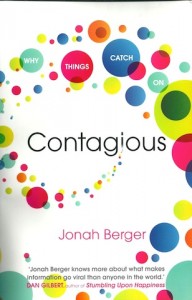The one-sentence summary
Your product or idea is more likely to catch on if you give it social currency, make it useful and emotional, and wrap it in an engaging narrative.
WHAT THE BOOK SAYS 
- The book is subtitled Why Things Catch On.
- It claims that you can increase your chances of your product or idea catching on (becoming contagious) by observing six specific approaches. The author presents these as a STEPPS mnemonic:
Social Currency: it needs to make people look intelligent if they pass it on. We share things that make us look good. Can you find an ‘inner remarkability’ and make people feel like insiders?
Triggers: provide related stimuli to remind people to talk about it. Top of mind leads to tip of tongue. Consider the context: what cues can make people think about your product or idea?
Emotion: when we care, we share. Ideas need to make people feel something. Concentrate on feelings: how can you kindle the fire and get people talking about it?
Public: we need to see other people engaging in the behaviour. If it’s built to show, it’s built to grow. Can people see when others are using your product, or create evidence that sticks around when they have done?
Practical Value: it needs to be useful – news you can use. Does the subject matter help people to help others?
Stories: narratives increase appeal and help engage people – information often travels under the guise of idle chatter. Is your product embedded in a broader narrative that people want to share?
WHAT’S GOOD ABOUT IT
- Word-of-mouth communication isn’t as random as one might think.
- Follow these components and your idea is more likely to ‘go viral’, or lead to social transmission.
- People don’t listen to advertisements – they listen to their peers, so this advice should help.
WHAT YOU HAVE TO WATCH
- There are many similarities to the work of Chip Heath, who is his teacher.
